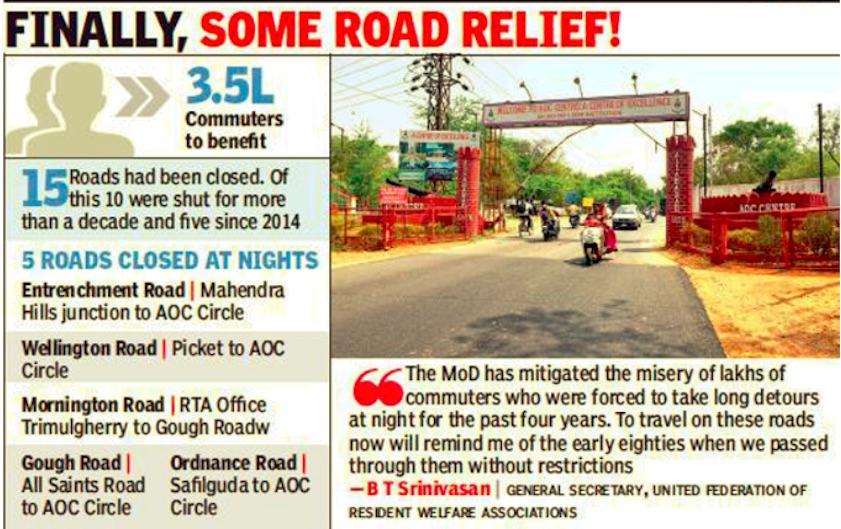Cantonments: India
This is a collection of articles archived for the excellence of their content. |
Contents |
Governance of Cantonments
Converting Cantonments into military stations/ 2018
Rajat Pandit, Army mulls abolishing all cantonments to save funds, July 13, 2018: The Times of India

From: Rajat Pandit, Army mulls abolishing all cantonments to save funds, July 13, 2018: The Times of India
Def Areas To Be Converted To Military Stns
Almost 250 years after the first cantonment to house troops was established at Barrackpore by the British, and their number slowly grew to 62 over time, the Army is now open to the idea of abolishing them across the country and saving funds spent on maintenance.
The Army has conveyed to the defence ministry (MoD) that military areas within cantonments can be converted into “exclusive military stations” with it exercising “absolute control” over them, while civilian areas are handed over to local municipal authorities for maintenance and other purposes, say officials.
The top Army hierarchy believes the step will help reduce the strain on the country’s defence budget for the annual maintenance of cantonments, which amounts to Rs 476 crore this year, as well as strengthen security in military stations, simplify land management and prevent encroachments.
Army chief Gen Bipin Rawat, in fact, has already ordered a feasibility study of the entire matter to be concluded by early September.
Civilians living in cantt areas are often deprived of govt’s schemes
The proposal to abolish cantonments is not new. Under a study team chaired by the defence secretary on the ‘Relevance of Cantonments in India’ in 2015, Mhow, Lucknow, Almora, Ahmednagar, Ferozepur and Yol cantonments were identified for excision of civilian areas. It is already underway at Yol,” said a senior officer.
But the proposed step is bound to generate a lot of controversy since similar moves have failed in the past due to widespread criticism that the powerful politician-builder lobby is eyeing cantonments after virtually running out of lucrative land in cities like Delhi, Mumbai, Lucknow, Pune, Kolkata, Ambala and others. It also comes at a time when a major section of the military community is up in arms over the MoD’s decision in May to reopen all closed roads in 62 cantonments for civilian commuter traffic.
Of the 17.3 lakh acres of land owned by MoD in the country, almost two lakh acres fall in the 62 cantonments in 19 states. When most of the cantonments came up before Independence, they were located far away from populated areas or on the outskirts of towns. But with the population explosion and growing urbanisation, cantonments now constitute prime property within cities.
Civilians living inside the cantonments are also often deprived of various welfare schemes sponsored by the central and state governments because they do not fall in “municipal boundaries” to be eligible for them.
Cantonment roads
2018: Cantonment roads to be open to public
Sunil Mungara, May 21, 2018: The Times of India

From: Sunil Mungara, May 21, 2018: The Times of India
It’s end of ‘road woes’ for about 3.5 lakh motorists, who pass through the Army Ordnance Corps (AOC) Centre in Secunderabad. The announcement by the Ministry of Defence (MoD) that all the closed roads in cantonments across the country will be reopened to the public has come as a major relief to the residents of colonies abutting the AOC Centre. Two arterial roads - Entrenchment and Gough - were scheduled for permanent closure from June 1. But now these two and other roads closed earlier will remain open to general traffic.
About 10 lakh people live in colonies around AOC and 3.5 lakh motorists use the AOC Centre roads daily. This also brings down the curtain on the four years of uncertainty over the AOC roads.
Secunderabad Cantonment as many as 15 roads were closed for security reasons. Ten roads were closed more than a decade ago. Five roads were closed in 2014. Two of these roads, however, remained open during the day. Now all the roads will be reopened.
MoD’s decision will be of great help to women employees, who return home after 10pm from offices. “Thanks to Nirmala Sitharaman, I will now reach home early. I need not take a long route to reach home,” said Akondi Hemalatha, senior manager, Sonata Software, and resident of Sitaram Nagar.
D Sravya Sahithi, an engineering student and resident of Dayandnagar, said it is a big relief. “I have been fighting against the closure of roads ever since I became an MP. All civilian roads will be kept open now. My efforts have yielded fruits,” said Malkajgiri MP Ch Malla Reddy while thanking defence minister Nirmala Sitharaman.